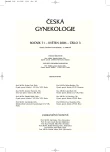Effect of Early Onset of Transdermal and Oral Estrogen Therapy on the Lipid Profile: a Prospective Study with Cross-over Design
Authors:
Tomáš Fait 1; M. Vráblík 2; Z. Žižka 1; B. Trnková 3; J. Mašata 1; J. Živný 1
Authors‘ workplace:
Gynekologicko-porodnická klinika 1. LF UK a VFN, Praha, prof. MUDr. A. Martan, DrSc.
1; III. interní klinika 1. LF UK a VFN, Praha, prof. MUDr. Š. Svačina, DrSc. MBA.
2; Ústav klinické biochemie a laboratorní diagnostiky 1. LF UK a VFN, Praha, prof. MUDr. T. Zima, DrSc.
MBA.
3
Published in:
Ceska Gynekol 2006; 71(3): 226-230
Category:
Original Article
Overview
Objective:
The aim of study was to evaluate changes of lipid profil during different types of estrogen replacement therapy (ERT).
Design:
Prospective randomized study.
Setting:
1st Faculty of Medicine and General Faculty Hospital Prague.
Methods:
Two routes of administration were used for 12 weeks: oral estradiol 2 mg/day and transdermal estradiol 50 μg/day (7-day pathes). Forty five healthy women with average age 49 ± 6 years were randomised into prospective cross-over designed study. Forty one women finished the study and were analysed. Blood collections were performed from veins on the beginning of study and during last week of each therapeutic interventions. Statistical results have counted by paired t-test.
Results:
Total cholesterol levels were not changed. Triglycerides grew up from 1,39 ± 0,9 mmol/l to 1.61 ± 0.8 mmol/l (p = 0,004) after oral ERT. This results showed significant (p = 0.0001) differences between oral and transdermal application because of nonsignificant (p = 0.187) lowering trends after transdermal ERT. The elevation of HDL levels after oral ERT (from 1.85 ± 0.39 mmol/l to 2.09 ± 0.42 mmol/l, p = 0.0001) was significantly (p = 0.009) more favourable than after transdermal ERT (to 1.96 ± 0.42 mmol/l, p = 0.029). Changes of LDL levels are also more favourable (p = 0.0001). LDL levels decreased after oral ET from 3.06 ± 0.97 mmol/l to 2.52 ± 0.71 mmol/l in comparison with the nonsignificant decline on 3.0 ± 1.0 mmol/l after transdemal ERT.
Conclusion:
All data from lipid metabolism had more favourable changes after oral ET with the exception of triglycerides. Knowledge of the patient’s lipid profile and it’s changes after each type of estrogen applications enable doctors individualisation of hormone replacement therapy from this point of view.
Key words:
hormone replacement therapy, cardiovascular diseases, lipoproteins, cholesterol
Labels
Paediatric gynaecology Gynaecology and obstetrics Reproduction medicineArticle was published in
Czech Gynaecology

2006 Issue 3
Most read in this issue
- Discrepancy of Ultrasound Biometric Parameters of the Head (HC - Head Circumference, BPD - Biparietal Diameter) and Femur Length in Relation to Sex of the Fetus and Duration of Pregnancy
- Serum Antibodies against Annexin V and Other Phospholipids in Women with Fertility Failure
- Intrahepatic Cholestasis of Pregnancy – Four Case Reports
- Prevention of Rh (D) Alloimmunization in Rh (D) Negative Women in Pregnancy and after Birth of Rh (D) Positive Infant
